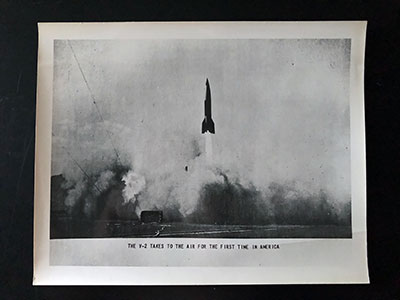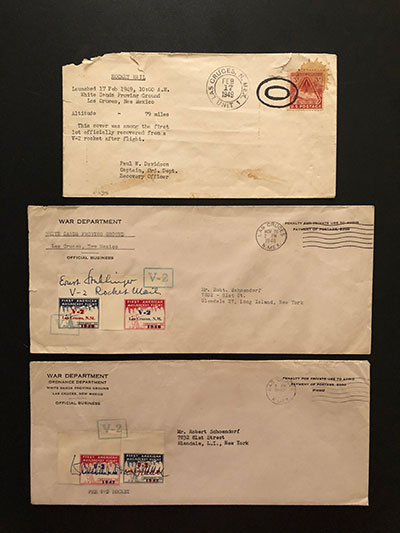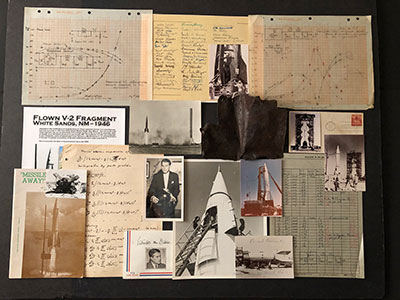Ken Havekotte
Member Posts: 2999
From: Merritt Island, Florida, Brevard
Registered: Mar 2001
|
 posted 04-21-2020 06:44 PM
posted 04-21-2020 06:44 PM
   
Not much has been said about flown V-2 postal mail (also rocket mail) from our nation's first large-scale missile and rocket launch facility. We're going back to the mid-1940's and early 1950's when the White Sands Proving Ground (WSPG) in New Mexico was created, first established in June 1945. It was the birthplace and gateway of America's missile, rocket, and space activities after the second world war had ended. But we all know the basic story when German rocket team leaders Gen. Walter Dornberger and Dr. Wernher von Braun along with 116 top rocket men specialists had surrendered to American army soldiers near a Bavarian ski resort in May 1945. With Nazi Germany in ruins, the V-2 rocket development team did not want to fall in the hands of the advancing Soviet Union troops. In a project known as Operation Paperclip, von Braun and his colleagues went to the United States under U.S. government contract to work for the Army in building and launching rockets. Their surrender enabled the Americans to capture large numbers of German V-2 rocket parts and components that would usher in the Space Age of our own missile, rocket, and space exploration programs. The V-2 had become the world's first long-range ballistic missile in 1942 and first rocket to reach space. For a generation, these men were the heart and soul of U.S. rocket and space developments during a time when V-2 rocket and space travel was exciting and catching newspaper headlines. Not only that, but the 1940/50's was a time when science fiction writers, space fantasy movies, and even UFO sightings of flying saucers were at a peak with the American public. Talk of space travel with rockets, spaceships, and future predictions of orbiting man-made satellites, man-in-space, and lunar/planetary voyages were popular in that era as the V-2's were flying scientific instruments to the edge of space. Without von Braun and his V-2 team, simply put, Americans would not have gone to the moon when they did. After coming to the United States in 1945-46, the original German rocket team had first arrived at Ft. Bliss, Texas, and would assemble, prepare, test, and launch captured V-2's about 50 miles down the road at the White Sands Proving Ground (later renamed the White Sands Missile Range in 1958). The vast-area desert range covers more than 3,200 square miles of southern New Mexico, which became America's first large-scale launch facility. Altogether, the team had enough parts and hardware to assemble at least 70 complete V-2's. The U.S. suddenly had the capability to launch large rockets and payloads weighing 2,000 pounds to altitudes exceeding 100 miles. The same German rocket team that had test fired earlier V-2's from their secret war-time Peenemunde rocket development-research center, north of Berlin on the Baltic sea coast, were now launching from U.S. soil the same-type, but slightly more modified, U.S.-improved V-2's for military purposes, high altitude upper atmosphere research, and space flight applications. They were joined by a team of mostly U.S. Army and General Electric/Hermes program engineers and technicians, taught by the Germans, in handling and firing the big 47-foot long V-2's from White Sands. The first V-2 rocket firing at WSPG wasn't for a launch, though, but was a crucial static test firing of the A4 rocket engine (original V-2 name) on March 15, 1946, at the 100,000 pound test stand built into the side of a mountain. The single-engine rocket stage, when fully fueled, weighed about 28,000 pounds and developed about 60,000 pounds of liftoff thrust, burning liquid oxygen fuel and a mixture of 75% ethyl alcohol and 25% water. The 25-ton engine test firing for the #1 V-2 rocket went well with no major problems or setbacks. Next up would be a different V-2, referred to as the #2 vehicle, that would be the first to actually fly. The first full-fledged V-2 took off April 16, 1946, and rose to an altitude of nearly 4 miles and crashed in a huge fireball. Though #2 did lift off successfully and flew for a few seconds, unfortunately, the flight was ruled a failure.  For the next V-2 flight, the Army at WSPG did something unusual by today's standards. They invited VIPs and the news media to witness the next launch "live" on the test range itself. With local town mayors, military leaders, reporters, and photographers watching, the second flight worthy V-2 took off on May 10, 1946, and flew as planned. It was a good day for the rocketeers. The #3 V-2 rocket from the desert proving ground climbed straight up, then pitched to the north, and reached a high point of almost 71 miles with a speed of about 3,500 mph and impacted about 35 miles downrange. It marked the first successful launch of a large rocket on American soil and accelerated the U.S. into the Space Age. Life Magazine, appropriately, ran a five-page photo spread of the historic rocket feat. A total of 67 V-2 rockets had been launched from White Sands from 1946-51. As an avid rocket enthusiast and space postal cover collector (but not an avid "rocket mail" collector) since my teenage years, I've often wondered if there had been any flown covers placed aboard any of those White Sands-flown V-2 rocket flights. World-renowned rocket and space mail collector Walter Hopferwieser of Salzburg, Austria, indicates that he's only aware of two V-2 flights carrying mail. The earliest known occasion was on Oct. 10, 1946, when V-2 flight #12 reached just about 101 miles above the earth. It was the second V-2 shot from the desert white sands of New Mexico that was able to reach over 100 miles high — well into "space" — with an engine burn time of nearly 68 seconds. Hopferwieser reported in his republished 2019 book, "Pioneer Rocket Mail & Space Mail," that perhaps 2-3 covers, addressed to New York collector Robert Schoendorf of the Long Island area, were onboard during the 90-second rocket trip. Apparently, the limited number of covers had been attached to the outer thin sheet steel surface of the captured V-2 and had been destroyed when the rocket's nose cone had crash landed some 12 miles from its launching site at Launch Complex 33. The ground impacted speed of V-2 #12 had been reported at 1,760 mph when the covers hit the ground. To my knowledge, though, assuming the story was true as reported, both covers were completely destroyed and not retained. As provided further by Hopferwieser in his book, along with the Ellington-Zwisler rocket mail catalogs, a brief mention in Jack McMahan's "Philatelic History of the Conquest of Space" published in 1972, and with other reference books (including Max Kronstrein's Rocket Mail Flights of the World), there were two envelope covers that were placed aboard V-2 Rocket #22, launched on April 1, 1947. The 22nd V-2 rocket had traveled 24 miles downrange reaching a peak altitude of nearly 80 miles above the earth after almost a minute of engine burn time. In a letter on April 2, 1947, M. D. Silkiner, an administrative assistant of the War Department, Ordnance unit, of the WSPG, had sent collector Robert Schoendorf two flown covers from the April 1st flight. Silkiner also requested in his letter that Scheondorf not publicize or exhibit his flown V-2 covers to the general public. At the top left of each cover is a typewritten inscription that reads, "Carried by V2 rocket at White Sands Proving Ground on April 1, 1947," and signed by Silkiner. In commemoration of the flown cover event, though, Schoendorf produced a few souvenir-type label vignettes. In stamp collecting, or philately, a vignette is a printed gummed label used for publicity purposes, but cannot be used for postage as they have no official postal validity. The New York astrophilatelist attached a few of them onto his own flown V-2 covers, which were reproductions of an earlier rocket "stamp vignette" issue of the first American Mail Rocket Flight in 1936 with an overprinted text, "V-2 Las Cruces, N.M. 1947." They were printed in sheets of four with different overprint colors with the V-2 references since 1946. Below are a couple of display presentations in celebration of V-2 rocket history here in the U.S. at New Mexico. The first panel depicts three unusual envelope- covers. The #10 business size envelopes were prepared by Silkiner and mailed to collector acquaintance Schoendorf in 1946/47.  The earliest "cover," seen as the middle cover above, with Schoendorf's typed address on it is an "official business War Department" postage-paid government envelope by WSPG. It contains two imprinted "V-2" 1946 blue and red label vignettes at bottom left along with a small boxed-in "V-2" green rubber stamp cachet. Right above both vignettes is the vintage signature of famed rocket pioneer Dr. Ernst Stuhlinger of the original German/von Braun rocket team. He also added by his own hand, "V-2 Rocket Mail," right below his autograph. At top right is a Las Cruces, NM, machine cancel on Nov. 20, 1946, which does not match any V-2 rocket launch day recording at White Sands. There is a second envelope, seen at top bottom, which is very much similar to the first. But this one is a printed "Ordnance Department (same "War Department" at top as the first) White Sands Proving Ground at Las Cruces, New Mexico" envelope. It's got the same pair of V-2 vignettes affixed at bottom left with the green "V-2" rubber stamp applied, however, Dr. Wernher von Braun himself signed this one across the twin vignette labels. The postmark is a machine cancel at Las Cruces in 1947 with just "3 pm" in the center die hub, but with no month. At the very bottom of the envelope below the vignette pair is a type-written cachet, "PER V*2 ROCKET." Does this mean the entire envelope and/or pair of affixed vignette souvenir labels did actually fly on a V-2 rocket in 1947 as the cancel reads? They're not listed in any of the rocket mail catalogs as being V-2 flown, though. But why indicate "V-2 Rocket Mail" and "Per V-2 Rocket" if not a flown vignette or envelope? As of this report, there are at least two other known WSPG government envelopes out there. Both have a pair of V-2 rocket vignette labels attached as well with postal cancels at Las Cruces on Oct. 17, 1946, and April 30, 1947. At the upper top left corners of both envelopes is typed "Per V-2 Rocket" with vintage-era Wernher von Braun autographs at bottom below the vignettes. Now though — for the grand finale — at the top of the first panel is a most unusual cover. It's torn a bit at the upper left corner and has a 1948 Fort Bliss 3- cent U.S. postage stamp affixed. You can either see a small coffee or tea-spilled stain over the stamp's top-right hand portion. There is also a thick black ink oval cancel touching the first USPS "rocket" stamp issue, but more intriguing to the left of the oval impression, is a circular "Las Cruces, N. Mex. Unit 1" postmark of Feb. 17, 1949.  To the best of my knowledge, with almost a lifetime of space cover/stamp collecting, it's the only 1949 American V-2 launch day cover I have come across, and with a clear Las Cruces "launch day" cancel on it. The old cover does show damage, perhaps from age, and with another envelope tear, though minor, at the cover's top and off to the side of the Scott #976 stamp issue along with some unusual glue-type cover stains. The cover's left side in the cachet area is a typed-in 1l-text line description that reads, "ROCKET MAIL / Launched 17 Feb. 1949, 10 A.M. / White Sands Proving Ground / Las Cruces, New Mexico / Altitude - 79 miles / This cover was among the first lot officially recovered from a V-2 rocket after flight / Paul W. Davidson, Captain, Ord. Dept., Recovery Officer." The closest post office near the actual V-2 launch site would be the Las Cruces area of NM more than 20 miles away. The next town nearby would be the military base of Alamogordo, located on the eastern side of the test range, 35 miles away. The better choice of a postal cancellation would indeed be Las Cruces, on the western side of the proving ground. As of this time, I am still trying to research the event further, especially to see if there was in fact an army captain by the name of Paul Davidson in Feb. 1949 that worked for the Ordnance Dept. at WSPG. The cover event though, however, was for an actual V-2 rocket "space" flight on the same day of the Las Cruces 2-17-49 cancel date. It was the 48th V-2 rocket, launched at 10 that morning as the cachet depicts, with the V-2 reaching 79 miles above the earth with a downrange distance of 37 miles after an engine burn-out time of almost 64 seconds. Little else is know about the cover, but it was a part of a large distinguished rocket mail collection that had appeared in a national stamp auction more than 20 years ago. Is the cover real or not, was it flown as described, is the Las Cruces postmark genuine, or could the whole cover, or parts of it, be a fake? Walter Hopferwieser feels that it may be authentic based on a couple of contributing factors, but of course, it would need more provenance and solid documentation if a flown cover. The Las Cruces postal cancellation on it, however, appears to be authentic, but it may require a closer study in comparison to other known Las Cruces postal strike impressions from the 1940's that I have seen on the websites of distinguished rocket mail/space collectors, such as Hopferwieser, Ben Ramkissoon, Beatrice Bachmann, Miri Matejka, and a few others. But even a cover not flown with such a cancel location is very difficult to find these days. But the typewritten sentence of, "This cover was among the first lot officially recovered from a V-2 rocket after flight," is most interesting, but for now, it posses more questions. What "first" cover lot is it referring to and why was it an "official" payload of sorts that no one else seems to know anything about, some 70 years ago? Perhaps though, and just a thought; maybe Captain Davidson was a "private" collector himself that arranged to have a single cover(s) placed onboard V-2 #48 because of his close military work-ties as a V-2 recovery officer at the proving ground facility throughout that time period. If flown on a V-2 rocket, the 1949 cover shares an unique history of WSPG when our nation was on the verge of exploring space for the first time. The V-2's with their scientific payloads and experiments set a variety of firsts for America's space programs. Milestones included achieving the first high-altitude and velocity records for a single- stage rocket, in addition, a V-2 from White Sands was the first rocket to be fully controlled in flight and served as a booster rocket for a smaller rocket stage mounted above it — the world's first large-scale, two-stage space vehicle. In October 1946, motion picture footage taken from a V-2 captured 40,000 square miles of earth's surface, and five months later, another V-2 camera brought back the first "space" photos of our planet from more than 100 miles up. The most important V-2 experiments were probably the Albert series of monkey flights from 1948-49 with studies of G-force accelerations at liftoff and weightlessness experienced at flight apogees. Such early animal studies at such altitudes gave scientists confidence that a man would some day be able to safely ride a rocket into space. The American public during the post WWII decade took more interest and pride in the development of this amazing new technology, and let's not forget, the V-2 was the forerunner or grandfather of launch vehicles used to launch our first orbital satellite, the first U.S. astronauts into space, put Apollo astronauts on the moon, and orbit our first manned space station. |














